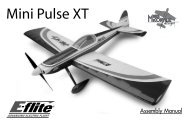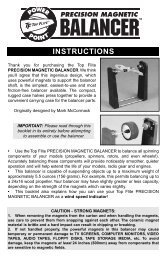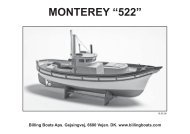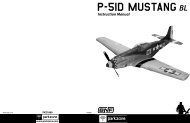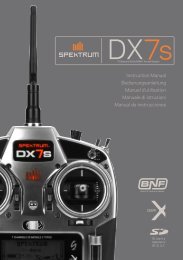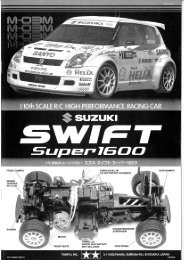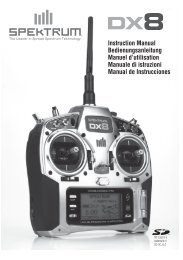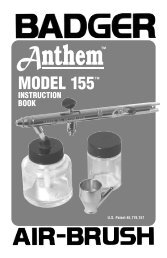Instruction Manual
Instruction Manual
Instruction Manual
You also want an ePaper? Increase the reach of your titles
YUMPU automatically turns print PDFs into web optimized ePapers that Google loves.
Thank you for buying a GY240 AVCS gyro.Before using your new gyro, please read this manual thoroughly and usethe gyro properly and safely. After reading this manual, store it in a safeplace.• No part of this manual may be reproduced in any form without prior permission.• The contents of this manual are subject to change without prior notice.• This manual has been carefully written. Please write to Futaba if you feel that any correctionsor clarifications should be made.2FEATURESAdoption of AVCSSince rudder trim changes caused by changes in tailreaction torque changes due to wind and other meteorologicalchanges and main rotor rotation variations are automaticallycancelled, tail (rudder) operation is easy, making itperfect for beginners.SMM gyro sensorUse of a new extremely small drift SMM (Silicon MicroMachine) gyro sensor virtually eliminates rudder trimchanges during flight.High-speed, high-precision controlHigh-speed, high-precision control realized by digitaladvanced control by microcomputer.Small, light weight, integrated typeSmall size (27 x 27 x 20mm) and light weight (25g) arerealized through high precision mounting technology.Conductive resin caseConductive resin case improves anti-EMI (static electricity,radiowave interference) characteristic.1FOREWORDThe GY240 is a high performance, small, and light weightAVCS (Angular Vector Control System) gyro developedfor model helicopters.Because the sensor section and control circuit are integrated,mounting is easy.AVCS GyroConventional gyros send control signals to the rudder servoonly when the tail of the helicopter moves. When the tailstops moving, the control signal from the gyro becomeszero. Conversely, the AVCS gyro continues to send controlsignals to the servo even when the tail of the helicopterstops moving.The following sequentially describes the conventional gyroand the AVCS gyro.Operation of Conventional GyroBasic operation is described by considering the case whenthe helicopter is hovering under cross-wind conditions.With a conventional gyro, when the helicopter encounters across-wind, the force of the cross-wind causes the tail of theSpecial Markingshelicopter to drift. When the tail drifts, the gyro generates acontrol signal that stops the drift. When the tail stopsdrifting, the control signal from the gyro becomes zero. Ifthe cross-wind continues to cause the tail to drift in thisstate, the "stop" operation is repeated until the tail facesdownwind. This is called the "weathervane" effect.Conversely, with an AVCS gyro, when the helicopterencounters a cross-wind and the tail drifts, a control signalfrom the gyro stops the drift. At the same time, the gyrocomputes the drift angle and constantly outputs a controlsignal that resists the cross-wind. Therefore, drifting of thetail can be stopped even if the cross-wind continues toeffect the helicopter. In other words, the gyro itself automaticallycorrects (auto trim) changes in helicopter tail trimby cross-wind.Considering operation of an AVCS gyro, when the tail ofthe helicopter rotates, the servo also rotates in accordancewith the angle of rotation of the tail. When the tail stopsrotating, the servo judges that it has stopped in that position.This is the auto trim function.Pay special attention to the safety at the parts of this manual that are indicated by the following marks.MarkOperation of AVCS GyroMeaningProcedures which may lead to a dangerous condition and cause death or serious injury to theuser if not carried out properly.Procedures which may lead to a dangerous condition or cause death or serious injury to theuser if not carried out properly, or procedures where the probability of superficial injury orphysical damage is high.Procedures where the possibility of serious injury to the user is small, but there is a danger ofinjury, or physical damage, if not carried out properly.3SET CONTENTSThe GY240 comes with the following accessories:GY240Ratings(Integrated sensor type AVCS rate gyro)• Control system: Digital advanced PI (Proportional Integration) control• Gyro sensor: SMM (Silicon Micro Machine) system vibration gyro• Operating voltage: +4 to +6VDC• Operating temperature range: -10˚C to +45˚C• Dimensions: 27 x 27 x 20mm• Weight: 25g (including connector)• Functions: Sensitivity trimmer, gyro operating direction adjustment switch,AVCS on/off switch4 FUNCTIONS AND CONNECTIONSMini screwdriver (for adjustments)AVCS on/off switch (AVCS)Turns the AVCS function on and off. In the "off" position, the GY240operates as a conventional gyro.Gyro direction switch (DIR)Switches the gyro control direction. Must be switched according to the mainrotor rotating direction and rudder linkage direction.(If you try to fly a helicopter with a clockwise rotation rotor with the gyro inthe reverse direction, the nose will swing to the left.)Gyro sensitivity trimmer (GAIN)Gyro sensitivity setting trimmer. Set to the maximum value at which the taildoes not hunt (minute vibration).Rudder input connectorConnects to the receiver rudder channel (ch4) output connector.Rudder servo connectorConnects the rudder servo.Double-sided tape (3 sheets)Rudder servoSymbol: ; Prohibited ; Mandatory
5 USEThis section describes how to use theGY240. Mount and adjust the GY240as described below.Switch and Trimmer OperationTo make the GY240 small and lightweight, a smallswitch and trimmer are also used. Be careful whenoperating the switch and trimmer. Always operate theswitch and trimmer with the mini screwdriver supplied.Mounting to Fuselage1 Set the AVCS on/off switch to "off".Push the white protruding part of theswitch in the arrow (down) direction.2 Install the GY240 body to the helicopter gyro bed usingthe double-sided sponge tape supplied with the GY240. Atthis time, check that the bottom of the gyro body is perpendicularto the main rotor shaft (parallel to the tail pipe).Double-sided sponge tapeGyro bedPerpendicularControl wireGY240When used with a motor helicopter, install the GY240at least 10cm away from the drive motor.3 Connect the GY240 rudder servo connector to the rudderservo.4 Connect the GY240 rudder input connector to thereceiver rudder channel (ch4) connector.5 Install the rudder servo and tail control wire linkage andservo horn in accordance with the helicopter instructionmanual. For the gyro to display top performance, it must belinked at a position at which the servo horn and control wireare perpendicular at the rudder neutral position.First, turn the trimmer fully clockwise.At this time, the position atwhich the trimmer cuts in is the100% position. Set the cut-in positionto the 75% position.8 If the rudder servo moves to the left when the nose of thehelicopter turned to the right, the gyro direction is correct.If the servo moves in the opposite direction, switch the gyrodirection switch.If the rudder servo moves in the oppositedirection, switch the switch.Set the length of the servohorn based on the modelmanufacturer's instructions.6 Try moving the rudder stick to the left and right, andcheck the direction of operation of the rudder servo. If therudder servo moves in the opposite direction, use thetransmitter reverse function to reverse it.7 Set the gyro sensitivity trimmer to the approximately75% position.Since this switch is close to the adjacentswitches, switch it carefully.* If you try to fly the helicopter while the gyro operationdirection is wrong, the nose will swing to the right or left.Flying AdjustmentIn the AVCS mode, the gyro automatically sets the rudderneutral position. Therefore, it is impossible to judge if themechanical rudder neutral position changed. Consequently,during initial flight and when correcting the linkage, turnoff the AVCS function and adjust the mechanical rudderneutral position.(Rudder neutral adjustment)1 First, to adjust the rudder neutral trim, start with theAVCS on/off switch in the "off" position.Since this switch is close to the adjacentswitches, switch it carefully.Push the white protruding part of the switch inthe arrow (down) direction.2 Set transmitter revolution mixing (pitch to rudder) to 0%or "off".3 Next, turn on the transmitter power, then turn on the gyropower (shared with the receiver, etc.). Since the GY240initializes the data when the power is turned on, never movethe helicopter for about three seconds.4 Lift off and hover, then adjust the rudder neutral positionwith the transmitter trim lever.For large deviation, use the fuselage linkage to adjustthe rudder neutral position.5 Adjust the gyro sensitivity to just before the helicoptertail starts to hunt.When hunting occurs, set to a lowervalue.Adjust the sensitivity graduallywhile checking for hunting.For more information, see .(AVCS Adjustment)6 Turn off the gyro power and turn on the AVCS on/offswitch.Since this switch is close to adjacentswitches, switch it carefully.Push the white protruding part of the switch inthe arrow (up) direction.7 In the transmitter power on state, turn on the gyro power.At this time, hold the transmitter rudder stick in the neutralposition and do not move the helicopter for approximatelythree seconds.8 Hover the helicopter and adjust the gyro sensitivity tojust before the helicopter begins to hunt.When hunting occurs, set to a lowervalue.Adjust the sensitivity graduallywhile checking for hunting.For more information, see .9 Adjust the rudder effect with the transmitter rudderadjustment functions (ATV, AFR, D/R, etc.).Rudder Neutral AdjustmentIn the AVCS mode, the servo does not return to the neutralposition even when the rudder stick is returned to the neutralposition. When you want to check the servo neutralposition during linkage neutral check, etc., set the AVCSswitch to the "off" position, or move the rudder stick atleast three times larger to the left and right in one secondintervals and immediately return the stick to the neutralposition. This operation resets the AVCS function andoutputs the neutral signal to the servo.Setting PrecautionsAlways use the attached sensor tape to mount the gyrosensor.Always reinstall the sensor tape if it has started to separateor tear.When mounting the GY240, leave a small margin sothat the gyro connection cable is not stretched tight.If the cable is stretched tight, the gyro will not display topperformance. If the gyro is dislodged, the gyro may malfunctionand is very dangerous.When used with a motor helicopter, mount the GY240as far away as possible (at least 10cm) from the drivemotor.The drive motor generates strong electromagnetic noise.This noise may interfere with the gyro sensor and causeerroneous operation.Mount the GY240 so that metal and other conductiveparts do not touch the case of the GY240.The GY240 uses a conductive resin case to reduce staticelectricity and electromagnetic interference. Since thesurface of the case is conductive, it may cause a shortcircuit.Insert the connectors fully and firmly.If vibration, etc. causes a connector to work loose duringflight, the heli may crash.Fuselage Maintenance PrecautionsAlways perform proper maintenance for ultimateperformance.The rigidity of the fuselage tail has a large effect on gyroperformance.The gyro sensitivity also changes with the length of the servohorn.If the sensitivity is too low, lengthen the servo horn. Conversely,when hunting does not stop, shorten the servo horn.• To improve the tail control characteristic, a delay function isadded to the rudder control signal from the transmitter. Whenthis signal is passed through the gyro, movement of the servois slower than the transmitter rudder operation. This isnormal.• When the fuselage is static, the servo may move a little. Thisis normal and occurs because the gyro sensitivity is set to ahigh value.Operating PrecautionsDo not move the helicopter and the transmitter rudderstick from the neutral position during about 3 seconds(during initialization) when turning on the gyro power.Never use the transmitter rudder trim in the AVCSmode.When the power is turned on, the GY240 judges that therudder stick is in the neutral position. Operating the ruddertrim during flight will change the neutral position.Avoid sudden temperature changes.Sudden temperature changes will cause the neutral positionto change. For example, in the winter, do not fly immediatelyafter removing the model from inside a heated car andin the summer, do not fly immediately after removing themodel from inside an air conditioned car. Allow the modelto stand for about 10 minutes and turn on the power afterthe temperature inside the gyro has stabilized. Also, if thegyro is exposed to direct sunlight or is mounted near theengine, the temperature may change suddenly. Takesuitable measures so that the gyro is not exposed to directsunlight, etc.When using the GY240 in the AVCS mode, set revolutionmixing to OFF (or 0%).Check the remaining receiver and gyro/servo nicdbattery operating time during the adjustment stage anddecide how many flights are remaining.Make the fuselage vibration as small as possible.Fuselage vibration has an adverse affect on gyro operation.Repair ServiceBefore requesting repair, read this instruction manual againand recheck your system. Should the problem continue, requestrepair service as follows:Describe the problem in as much detail as possible and send itwith a detailed packing list together with the parts that requireservice.• Symptom (Including when the problem occurred)• System(Transmitter, Receiver, Servo's and model numbers)• Model (Model name)• Model Numbers and Quantity• Your Name, Address, and Telephone Number.If you have any questions regarding this product, please consultyour local hobby dealer or contact the Futaba ServiceCenter.FUTABA CORPORATIONMakuhari Techno Garden Bldg., B6F 1-3 Nakase, Mihama-ku, Chiba 261-8555, JapanPhone: (043) 296-5118 Facsimile: (043) 296-5124©FUTABA CORPORATION 2000, 4




